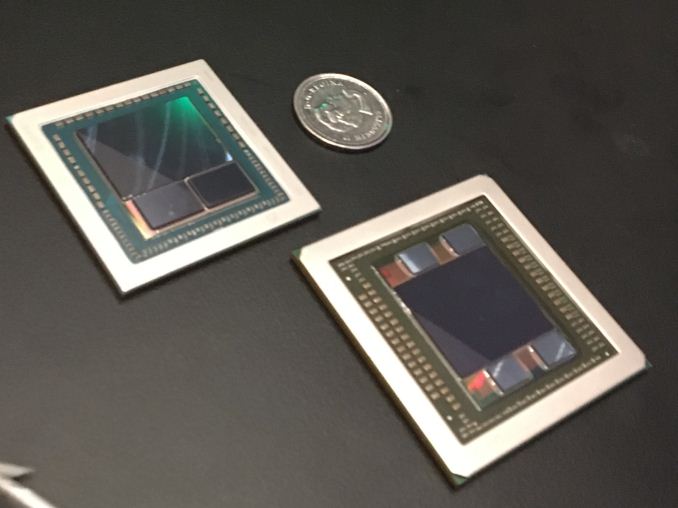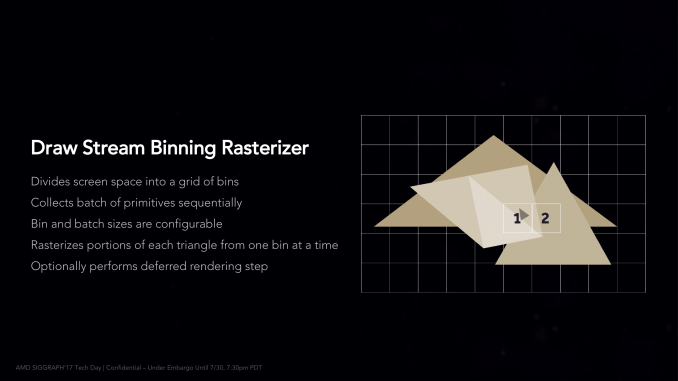Radeon RX Vega Unveiled: AMD Announces $499 RX Vega 64 & $399 RX Vega 56, Launching August 14th
by Ryan Smith on July 30, 2017 10:30 PM ESTFeatures & the Future Launch
Last but not least, along with today’s card announcements, AMD has also lifted the embargos on the architectural elements of the Vega 10 GPU. While there are no new architecture features to discuss – it turns out AMD was rather thorough with their preview at the start of this year – there’s still quite a bit in the way of details to dig into here. In fact it's more than I can hope to cover in a single day, let alone the few hours I’m getting to write this article ahead of AMD’s embargo. So I want to hit the highlights.
First and foremost, AMD has clarified that they do not consider Vega 10 to be a high performance computing (HPC) chip, unlike Hawaii. In particular, Vega 10’s native FP64 rate is just 1/16, like AMD’s other consumer chips. And the chip, while supporting HBM2’s native ECC mode, doesn’t have ECC on its internal pathways. This doesn’t mean that the chip can’t be placed in a server – its FP16 and INT16/INT8 performance is the cornerstone of its existence as part of the Radeon Instinct family. But that’s still a different market than traditional HPC. When we might see another HPC chip from AMD is anyone’s guess at this moment.
Second of all, we have a formal die size and transistor count for Vega 10. The GPU is officially 486mm2, containing 12.5B transistors therein. That amounts to 3.9B more transistors than Fiji – an especially apt comparison since Fiji is also a 64 CU/64 ROP card – all the while being 112mm2 smaller than Fiji (despite the higher transistor count) thanks to the higher density of GloFo’s 14nm LPP process, which AMD is using to fab the chip.
Talking to AMD’s engineers, what especially surprised me is where the bulk of those transistors went; the single largest consumer of the additional 3.9B transistors was spent on designing the chip to clock much higher than Fiji. Vega 10 can reach 1.7GHz, whereas Fiji couldn’t do much more than 1.05GHz. Additional transistors are needed to add pipeline stages at various points or build in latency hiding mechanisms, as electrons can only move so far on a single clock cycle; this is something we’ve seen in NVIDIA’s Pascal, not to mention countless CPU designs. Still, what it means is that those 3.9B transistors are serving a very important performance purpose: allowing AMD to clock the card high enough to see significant performance gains over Fiji.
Speaking of Fiji, there’s been some question over whether the already shipping Vega FE cards had AMD’s Draw Steam Binning Rasterizer enabled, which is one of the Vega architecture’s new features. The short answer is that no, the DSBR is not enabled in Vega FE’s current drivers. Whereas we have been told to expect it with the RX Vega launch. AMD is being careful not to make too many promises here – the performance and power impact of the DSBR vary wildly with the software used – but it means that the RX Vega will have a bit more going on than the Vega FE at launch.
Fifth, AMD is tweaking their boost clock mechanism and how it's advertised. Up until now, the boost clock was the maximum clock a Radeon card would hit. e.g. a stock Fury X topped out at 1.05GHz, and a stock RX 580 at 1340MHz. Starting with Vega RX, however, the company's definition of the boost clock is changing to the highest clockspeed a card is guaranteed to hit, but not the absolute highest clockspeed it can hit under load. There are still some nuances I want to test once I have the hardware in-hand, but at first glance this sounds closer to NVIDIA's definition, where each and every card is allowed to reach its natural limit (for the stock voltage).
Finally, while AMD didn’t clarify exactly when this change was made, the company has tweaked their Freesync Low Framerate Compensation technology to work with monitors that have a 2x range between min and max refresh rates, as opposed to 2.5x at launch. I’m told that 2.5x (or better) is still the ideal range, but it now works at 2x. This is an important development because the Samsung CF791 monitor that AMD is discounting as part of the Radeon Pack bundles has a 48Hz to 100Hz range; so it wouldn’t have been LFC capable under the old LFC rules.
Overall AMD has given us a lot to chew on – and more that can be covered in a single afternoon – but we still haven’t seen the whole picture. Today’s announcement of the card specifications and prices sets a very important baseline for what we should expect on August 14th, but no hard performance numbers to judge the final product. As I said at the start of this article, AMD’s marketing has done a very good job keeping Vega in the public’s mind. And today’s announcement is the next phase of that plan. But the end is approaching, and RX Vega’s full launch is drawing near, so it will be very interesting to see how everything we’ve learned over the last several months translates into gaming performance, power efficiency, and where AMD’s new place shall be in the realm of high-end video cards.













162 Comments
View All Comments
CiccioB - Thursday, August 3, 2017 - link
Yeah, you are right. It was Polaris. I often mismatch them as they both are similar. My fault.lordken - Tuesday, August 1, 2017 - link
Well even if Vega will slot in between 1080-ti in performance it won't survive long IMHO. NV can further slash 1080 and 1070 prices (as they milked enough) and I can't see how Vega would sell. I guess AMD can't go much lower with price either...Not to mention AMD lost many potential buyers after NV dropped Ti and lowered 1080 price few months back.
Outlander_04 - Tuesday, August 1, 2017 - link
You do know that its hard to find a polaris card because demand is so high, right?CiccioB - Thursday, August 3, 2017 - link
That was surely not for any AMD concurrency. There was zero from that front.
It simply meant nvidia touched the maximum margins it could have with those products (it is a thing that limits the market even in a monopoly) and had to lower them to raise the number of sold units = higher volumes of money in nevertheless.
I bet that Vega will not change nvidia prices. Too few, too late and in very limited quantity. AMD has not interests in selling Vega in consumer market apart from a showcase: it costs them too much. And HBM2 is not that abundant.
giantmonkey101 - Tuesday, August 1, 2017 - link
Honestly Vega is looking like an amazing upgrade for me check out these numbers i calculated35% to 45% increase in performance upgrading to the liquid cooled Vega 64@1677Mhz over my r9 fury@1000Mhz, even higher minimum framerates for smoother gameplay according to their numbers and i get Enhanced Vsync as well since its not available on Fiji has of yet. Consider i saw 30% to 35% going from an r9 290 to a R9 Fury non x in gaming, this is even better for me. yes if you own a 1080 or especially 1080 ti this is not an upgrade path lol unless you wanna get into the Radeon Ecosystem of course.
giantmonkey101 - Tuesday, August 1, 2017 - link
Also these are based on current numbers, if you add in DSBR support on day one launch and Super fine wine tech like massive fp16 performance in Vega and other tech features you will see even greater numbers in the future also increases in optimisation in games just like the rx 480 saw 10% performance gain over 6 months which put it trading blows with a 1060 eventually in DX11 and DX12.Ymir - Tuesday, August 1, 2017 - link
DSBR was already enabled for the AMD tests in the slide deck. It shows an 18% increase on Doom compared to the FE on a driver that is not out to the public yet. DSBR is not a magical thing that will make everything lovely. Look for the tech articles on it at retail launch.syrious - Tuesday, August 1, 2017 - link
These cards are so ugly.fanofanand - Wednesday, August 2, 2017 - link
I was very excited for Vega. Along the way, I simply got bored and lost interest. Sorry AMD, but you aren't just late this time, you still haven't even shown up. These cards were supposed to be launched a LONG time ago, with the most recent statements saying July. Well here we are in August and nobody can buy one.milkod2001 - Thursday, August 3, 2017 - link
On 14th August Vega 64 with custom cooler from ASUS should be available. That's less than 2 weeks to wait ,we still don't know about its performance apart from AMD claiming it will be very competitive. I can see 2 possibilities there: Vega is quite pathetic product with average performance and super high power draw or Vega is great and AMD as usual suck big time at advertising its products.